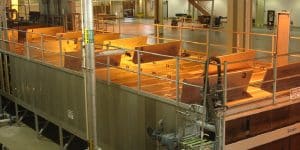Many types of industrial and agricultural equipment can experience explosions or deflagration events. Explosion relief vents and doors lessen their impact by releasing the sudden pressure increase in a safe direction. This ensures the structural integrity of the vessel containing the explosion isn’t compromised and stops anyone nearby from being injured.
You might consider explosion relief vents and doors a form of insurance: ideally, they will never be needed, but if an event does occur they’ll help you avoid a lot of cost and disruption. However, this is only true if they operate quickly and effectively.
This blog post explains how to select dependable vents and doors, but first, we’ll consider how they work and where they should be used.
HOW EXPLOSION RELIEF DOORS WORK
Two types of devices provide explosion relief: doors and panels. Together these are often referred to as vents. Both are designed to open quickly when pressure builds suddenly behind them. The main difference is that doors are designed to be reusable while panels are single-use devices.
As the name suggests, an explosion relief door has hinges that let it open and close. In contrast, a panel is an area of material that ruptures when the pressure increases suddenly on one side. Doors are designed to operate at lower pressures than panels. They can be opened to allow for inspections or cleaning.
Both doors and panels are best incorporated into equipment when it is first built. Explosion relief doors can be retrofitted to existing equipment but this may be harder to do with panels.
Quality explosion relief doors, like those made by SMT, consist of a spring-loaded panel within a larger door frame. The door is held closed by a special magnetic latch.
An explosion or deflagration (rapid burning) event causes a pressure wave that pushes the spring-loaded panel away from its seal. This triggers the latch to release the door within milliseconds once the pressure setpoint has been reached.
WHEN AND WHERE EXPLOSION RELIEF DOORS ARE USED
Any equipment where there’s a risk of an internal explosion will benefit from explosion relief, but on most high-risk vessels it’s required by safety bodies like OHSA. Examples include dust collectors, spray dryers, rotary kilns, gas-fired combustion equipment, and almost all types of dust handling machinery.
Dust is a major cause of explosions in industrial, agricultural, and food processing equipment. Even if the material being processed isn’t typically thought of as being combustible, like metals, it can burn rapidly in dust form with the right particle size and concentration.
The reason is that dust has a large surface-to-volume ratio. Combine dust with oxygen and you have two of the three things needed for a fire. Add the third, an ignition source, and the result can be a rapidly burning fireball that moves quickly through the containment vessel.
OSHA identifies a long list of combustible dust. These range from sugar and wood flour to tea, zinc, and melamine resin. They can build up over time on surfaces, in corners of ducts, and on bracing and other parts of the equipment. Then, when a spark comes along, the result is an explosion.
WHAT TO LOOK FOR IN EXPLOSION RELIEF VENTS AND DOORS
These are devices that hopefully sit unused for years, but when needed must react within milliseconds. For this reason, it is important to specify and/or buy quality products, but how can you tell which are good and which aren’t? Here are seven points to look for.
- The manufacturer’s track record in explosion relief – It takes a lot of experience to produce high-quality safety devices like these. Be sure to buy from established companies that have the know-how and manufacturing expertise.
- Proven designs – Ask prospective suppliers for evidence that their explosion relief vents and doors are used in a variety of industries and applications. This will show they have a reliable and successful product.
- Advice on vent sizing and placement – The manufacturer needs to be able to calculate the explosion relief area needed according to NFPA 68 requirements for your materials and size as well as type of structure and advise on the best location for your doors/vents.
- Low inertia – It’s essential that explosion relief doors open quickly. One factor in this is low inertia, as is achieved with the honeycomb structures used by SMT.
- Durable, low/no maintenance materials – Look for stainless steel in latch springs, hinges, fasteners, frames, and panels, along with self-lubricating sleeve bearings.
- Customizable designs for the opening area and pressure – The manufacturer should be willing to adjust doors to meet the particular requirements of your equipment and materials.
- Upgradeable components – Your needs might change in the future. Doors with components that can be upgraded will avoid having to make wholesale replacements.
KNOW WHAT YOU’RE BUYING
Explosion relief vents are things that you hope are never needed, but if something goes wrong they will help you avoid a lot of damage, expense, and possibly injury. That’s why you should never cut corners or buy or specify inferior products.
The seven points listed in this blog post will help you determine whether the explosion relief vents and doors you’re looking at will provide the service you need.
To learn more, click below.







 Contract
Contract Food & Bev
Food & Bev